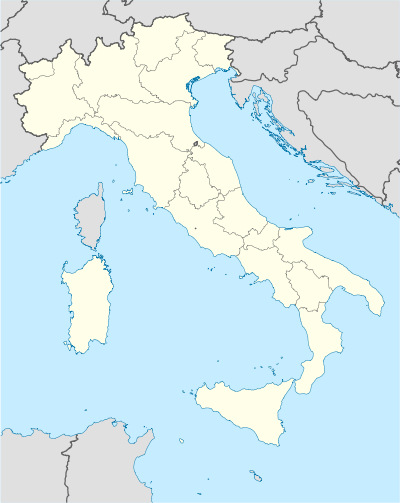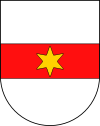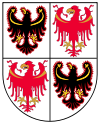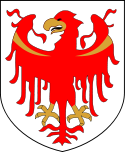Bolzano
| Bolzano Stadt Bozen |
|||
|---|---|---|---|
| — Comune — | |||
| Città di Bolzano | |||
|
|
|||
|
|||
 Bolzano
|
|||
| Coordinates: | |||
| Country | Italy | ||
| Region | Trentino-Alto Adige/Südtirol | ||
| Province | Bolzano-Bozen (BZ) | ||
| Government | |||
| - Mayor | Luigi Spagnolli (Democratic Party) | ||
| Area | |||
| - Total | 52.34 km2 (20.2 sq mi) | ||
| Elevation | 262 m (860 ft) | ||
| Population (September 30, 2009) | |||
| - Total | 102,880 | ||
| - Density | 1,965.6/km2 (5,090.9/sq mi) | ||
| Demonym | Italian: bolzanini German: Bozner |
||
| Time zone | CET (UTC+1) | ||
| - Summer (DST) | CEST (UTC+2) | ||
| Postal code | 39100 | ||
| Dialing code | 0471 | ||
| Website | Official website | ||
Bolzano listen (Italian) or Bozen (German) (Ladin: Bulsan; Latin: Bauzanum) is a city and comune in the Trentino-Alto Adige/Südtirol region of Italy. Bolzano is also the capital of the province of Bolzano-Bozen, also known as Südtirol in German, and in English as South Tyrol.
The South Tyrol Museum of Archaeology in Bolzano/Bozen is where the ice mummy "Ötzi" is kept.
Bolzano is the seat of the Free University of Bozen-Bolzano, where lectures and seminars held in German, Italian and English reflect the multilingual status of the region.
In 2008 Bolzano was one of the locations, in the region Trentino-Alto Adige, where the seventh edition of the world renowned Manifesta, the European Biennial of Contemporary Art was held.
The city is also the home of the Italian Army's Alpini High Command (COMALP) and some of its combat and support units.[1]
Contents |
History

Inhabited by the Raetian Eisack people, a settlement was built by the Romans after the area's conquest by general Nero Claudius Drusus in 15 BC, to whom the name of the settlement Pons Drusi ("Drusus Bridge") referred. The nearby village was called Bauzanum. With the end of the Roman empire a Bavarian immigration began and the first mentioning of a Bavarian count as ruler of Bozen dates from 679. The area has been settled by German populations since then. Bozen has been an important trading point since its elevation to a town on June 24, 1190 by bishop Konrad of Trient, due to its location in between the two major cities of Venice and Augsburg. Four times a year a market was held and traders came from the south and the north. The mercantile magistrate was therefore founded in 1635. Every market season two Italic and two Germanic officers (appointed from the traders who operated there) worked in this office. The city was a cultural crosspoint at that time, and still is to this day.[2]
Before World War I, Bolzano was part of the Austro–Hungarian county of Tyrol. It was annexed by Italy at the end of World War I and on January 1, 1927 became a provincial capital. At the time of its annexation, Bozen was an ethnic German city, with a pre-war population of 30,000 people, 95.52% of whom were German native speakers. In the 1920s the city, along with the rest of South Tyrol, was subjected to an intensive Italianization programme under orders from Benito Mussolini. The aim was to outnumber the local German-speaking population by tripling the population with Italian immigrants drawn from the old provinces.[3]
During World War II, Bolzano was the site of the Nazi Bolzano Transit Camp, a concentration camp for Jews and political prisoners.
Society and economy
According to the 2001 census, 73% of the city inhabitants speak Italian, 26.29% German and 0.71% Ladin as their first language.[4] The city thrives on a mix of old and new—high-quality intensive agriculture (including wine, fruit and dairy products), tourism, traditional handicraft (wood, ceramics) and advanced services. Heavy industry (machinery, automotive, steel) installed during the 1930s has now been mostly dismantled. On the downside, the local economy is very dependent on the public sector, and especially the provincial government.
Bolzano is the biggest city in South Tyrol (Alto Adige in Italian), which is an autonomous province in Northern Italy with a special statute. This statute preserves the rights of the German minority in Italy. This unique system has been admired by the Dalai Lama, who visited the city on several occasions to study a possible application in Chinese-occupied Tibet.
Bolzano was ranked as having the second highest quality of life of Italian cities in 2007, with neighbouring Trento topping the list.[5]
Main sights

The city's with its medieval city center, Gothic and Romanesque churches and bilingual signage give it a unique flavour of a city at the crossroads between Italian and Austrian cultures. This, and its natural and cultural attractions make it a renowned tourist destination.
Among the major monuments and sights are:
- Walther Square, with a statue of Walther von der Vogelweide, a German minstrel (minnesinger)
- the Lauben, a mile long street in the city center with medieval arcades along its entire course, now housing countless high street shops
- the South Tyrol Museum of Archaeology, which hosts the mummy of Ötzi the Iceman
- the Gothic Cathedral, started in 1184, expanded in the 14th century by architects Martin and Peter Schiche (completed in 1382)
- the Old Parish church of Gries, with the Altarpiece of Michael Pacher
- the monastery of Muri-Gries, with baroque paintings of Martin Knoller
- various castles, including Castle Maretsch, Runkelstein Castle and Castle Firmian/Sigmundskron
- Victory Monument, a Victory gate built on orders from Benito Mussolini in 1928
- Messner Mountain Museum of Reinhold Messner
For more historical and geographical information, see Province of Bolzano-Bozen.
City districts and neighboring communities
.png)
City districts:
- Centro-Piani-Rencio (German: Zentrum-Bozner Boden-Rentsch)
- Don Bosco
- Europa-Novacella (German: Europa-Neustift)
- Gries-San Quirino (German: Gries-Quirein)
- Oltrisarco-Aslago (German: Oberau-Haslach)
Neighbouring communities are: Eppan an der Weinstraße, Karneid, Laives, Deutschnofen, Ritten, Jenesien, Terlan, and Vadena.
Other important nearby towns are Brixen, Bruneck and Meran.
Transportation
The city is connected to the highway A22-E45[6] to Trento and Verona and to Innsbruck (Austria) and Munich (Germany). Bolzano is also connected to the Railway system. Bolzano is located on the main route between Italy and Germany.
Different airlines provide flights from Bolzano Airport (IATA: BZO) to Rome, Vienna, Milan and other destinations.
Sport
The town is host to an annual road running competition – the BOclassic – which features an elite men's 10K and women's 5K races. The event, first held in 1975, takes place on New Year's Eve and is broadcast live on television by Rai Sport Più.[7][8]
Local teams
- Football
- F.C. Südtirol-Alto Adige plays in Lega Pro Seconda Divisione (Promoted to Lega Pro Prima Divisione in 2009-10 season)
- F.C. Bolzano 1996 played 2008/09 in Eccellenza but was relegated
- Handball
- SSV Bozen Handball A1
- Ice hockey
- HC Bolzano Bozen Foxes plays in Serie A
- EV Bozen 96 plays in Serie A
- Rugby
- Sudtirolo Rugby Cavaliers The Cavaliers plays in Serie C
- American Football
- Giants Bolzano The Giants plays in IFL (Italian Football League), the first league of the FIDAF
Twin cities
 Sopron, Hungary
Sopron, Hungary
References
- ↑ Le unità di supporto del Comando Truppe Alpine(Italian)
- ↑ Bozner Chronik, Ferdinand Troyer; Bozen 1648
- ↑ City of Bolzano City publicatione (Italian)
- ↑ Oscar Benvenuto (ed.): "South Tyrol in Figures 2008", Provincial Statistics Institute of the Autonomous Province of South Tyrol, Bozen/Bolzano 2007, p. 16, table 10
- ↑ Ilsole24ore.com (Italian)
- ↑ A22.it Autostrada del Brennero SpA Brennerautobahn AG. Retrieved 2009-06-19.
- ↑ Sampaolo, Diego (2010-01-01). Three-peat for Soi in Bolzano. IAAF. Retrieved on 2010-05-20.
- ↑ Sampaolo, Diego (2008-12-31). Soi and Kibet at the double? Boclassic preview. IAAF. Retrieved on 2010-05-20.
External links
- (Italian) (German) Homepage of the city
- Tourism office of the city
- Bolzano Winery - Kellerei Bozen - Cantina Bolzano
- Bolzano travel guide from Wikitravel
|
|||||||||


